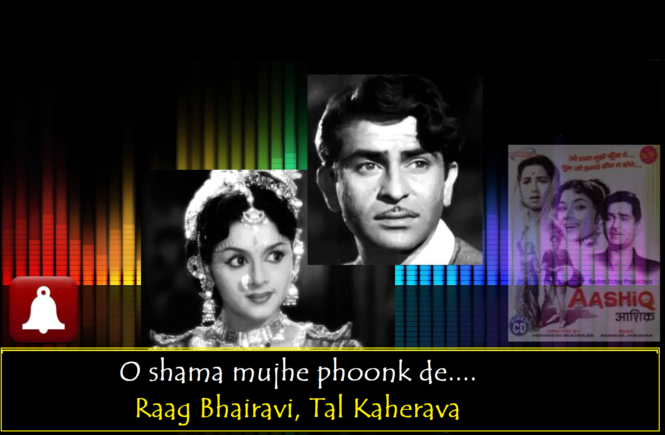Raaga Based Song of the Day: O shama mujhe phoonk de ….
Raag Bhairavi, Tal Kaherava
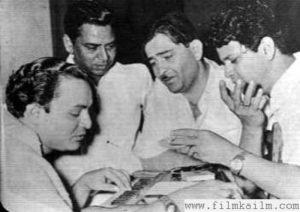
The favourite raag of Shankar Jaikishan again for the simple reason that there are dozens of beautiful songs composed by them in it and I haven’t given you anywhere close to enough. The 1962 movie Aashiq had something in common with the 1959 movie Anari in that both were directed by Hrishikesh Mukherjee. Both being Raj Kapoor starrers had no surprises in lyricists, composers and music directors, and singers. The songs of the movie were penned by Hasrat Jaipuri and Shailendra, composed by the greatest music duo in Hindi films: Shankar Jaikishan, and sung by Mukesh and Lata Mangeshkar.
If you were wondering as to why I brought the coincidence of Hrishikesh Mukherjee being the director of both the movies whose songs in Raag Bhairavi I have given in quick succession, then here is the main reason:
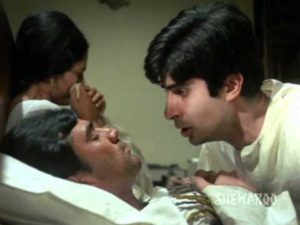
Hrishikesh Mukherjee and Raj Kapoor had a very close friendship. The most talked about movie of Hrishikesh Mukherjee was the 1971 movie Anand starring Rajesh Khanna in the title role and Amitabh Bachchan as his doctor Bhaskar Banerjee. Anand’s character was inspired by Raj Kapoor who was sick then. So fond was Hrishikesh Mukherjee of Raj Kapoor that he was fearful of losing him then. He said Raj Kapoor used to call him Babumoshai as Anand’s character calls the doctor in the film. Hence, we know that Amitabh Bachchan’s Bhaskar Banerjee is based on Hrishikesh Mukherjee himself, keeping the Bengali identity as a clue, and Rajesh Khanna was Anand Saigal, a Punjabi, like Raj Kapoor. That was the extent of their friendship.
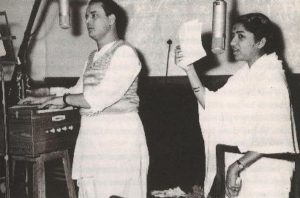
Mukesh and Lata Mangeshkar, the singers of the duet that I am giving you, made some of the most enchanting duets in Raj Kapoor movies. I had a Facebook group called Dil Ki Nazar Se based on the title of their duet in 1959 Hrishikesh Mukherjee movie Anari. Some of the other are: Aa ab laut chalen, Dum bhar jo udhar moonh phere, and Aaja re ab mera dil pukaara.
We have completed eighty days of Raaga Based Songs of the Day. Our first post in the series was titled ‘Raaga Based Song Of The Day #1’ and the song was a Mohammad Rafi and Lata Mangeshkar song from the 1970 Shakti Samanta movie Pagla Kahin Ka: Tum mujhe youn bhula na paoge. It is in Raag Jhinjhoti, Tal Kaherava.
Our eightieth post or the last post was titled ‘Raaga Based Song Of The Day #80‘ and the song was a Jagjit Kaur song from the 1964 Nazar movie Shagun starring Waheeda Rehman and her husband Kamalji: Tum apna ranj-o-gham apni pareshaani mujhe de do. It is in Raag Pahadi, Tal Kaherava.
This blog has a number of posts on Raaga based songs in Hindi movies titled similarly; for example: ‘The Best Raaga Based Songs in Hindi Movies – Raaga Darbari Kanada – Part II‘.
In the last eighty days of sharing Raaga based songs of the day, I have given you songs based on Raag Jhinjhoti, Gara, Bhimpalasi, Madhuvanti, Shivaranjani, Bihag, Pahadi, Sarang, Pilu, Bhairavi, Khammaj, Charukesi, Kalyan or Yaman, Desh, Malgunji, Kirwani, Kedar, Bageshri, Megh Malhar, Bhupali, Ahir Bhairav, Malkaush, Mand, Adana, Kafi, Rageshri, Jaunpuri, Tilang, Janasammohini, Chayanat, Shuddha Kalyan, Gaur Sarang, Jogiya, Asavari, Maru Bihag, Durga, Lalit, Puria Dhanashri, Bhinna Sahdja, Sohani, Multani, Patdeep, Jaijaiwanti, Tilak Kamod, Hemant, Basant Mukhari, Gujri Todi, Kalavati, Hamir, Bhatiyar, Gawati, Shyam Kalyan, Gorakh Kalyan, Madhamat Sarang, Manj Khammaj, Darbari Kanada, Vibhas, Shankara, Bahar, Nand and Mian Ki Malhar; making it a total of 61 raagas. The raagas that have been repeated so far are Pahadi, the raaga of my home place in the Himalayas, Maru Bihag, Raag Kirwani, Jhinjhoti, Bhairavi, Gara, Basant Mukhari, Malkauns, Bhairavi and Mand. Today, I am repeating Raaga Bhairavi again.
Today’s song has been sung by Lata Mangeshkar and Mukesh on the lyrics of Shailendra and composition by Shankar Jaikishan. As I said, it is in Raag Bhairavi, Tal Kaherava. The song is picturised on Raj Kapoor and Padmini. A word about them at this stage:
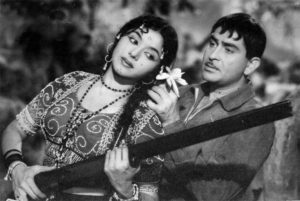
Raj Kapoor acted with Nargis in as many as 17 movies, from 1947 movie Aag to 1956 movie Chori Chori. Once the Raj Kapoor-Nargis era got over, Raj Kapoor was looking for a replacement. During the shooting of Chori Chori in Madras, Raj and Padmini came close as she was working in the next studio. After that they met in Moscow where Raj Kapoor had gone to attend Karlovy Vary Award Function and she was there with her sister Ragini for a Youth Festival. After the sudden departure of Nargis from Moscow, when Raj Kapoor fell ill, it was Padmini who nursed him. Raj Kapoor told his friends that he made the 1960 movie Jis Desh Mein Ganga Behati Hai with Padmini to express his gratitude to her. Rumours started abounding that Raj Kapoor was besotted with her due to her ample physicial assets. A proof of that was that Raj Kapoor turned to display her sensuousness in the movies, something that he hadn’t done with Nargis; eg, the song Ho maine pyar kiya picturised on Padmini in Jis Desh Mein Ganga Behati Hai was done in a swim suit and focussed on her cleavage and sexuality. Padmini was pregnant when she acted with Raj Kapoor in 1962 Hrishikesh Mukherjee Aashiq that was produced by Bunny Reuben and VK Dubey. There were rumours galore when she delivered in the 8th month of her marriage though most of these were later proved to be unfounded.
Before we actually take up the song, first, lets take up the value added learning of today. Today onwards we shall learn about some of the leading personalities in Indian Classical Music or Shastriya Sangeet. The first one is Ustaad Asad Ali Khan.
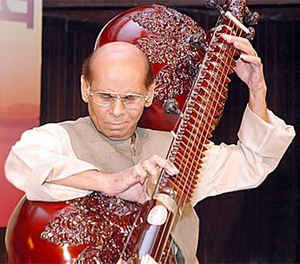
You would recall when I told you about Veena and especially Rudra Veena (Please see ‘Raaga Based Song Of The Day #48‘ and ‘Raaga Based Song Of The Day #49‘). Even though Veena is the oldest of the Indian musical instruments, after it was replaced by Sitar, very few displayed interest in playing Veena. Ustaad Asad Ali Khan (01 December 1937 – 14 June 2011) was the best Rudra Veena player that we ever had. For his dedication and mastery of the instrument he was awarded Padma Bhushan three years before he died. In addition, as early as in 1977, he was awarded the Sahitya Akademi Award.
Ustaad Asad Ali Khan belonged to a family of Veena players. He represented the Khandarbani Dhrupad style of the Jaipur Beenkar (Indore) gharana. Carsten Wicke (one of his students) in an obituary on his death wrote: “Whether as a musician, teacher, or human being – Khansahib’s biography was an example of how much alive the rudra veena can still be today. Nevertheless, the subtle sound of his veena and his lifelong dedication and self discipline often seemed like a memory from a long gone past already in his lifetime. Strict musical grammar combined with aesthetic refinement and artistic greatness were the wings on which the music flowed from his veena like a prayer. Although a devout Muslim it seemed completely natural to him to articulate his longing for God through the sounds of Hindu-based dhrupad music.”
Ustaad Asad Ali Khan He performed in many countries, including Australia, the United States, Afghanistan, and Italy and several other European countries, and conducted music courses in the United States. He criticised unwillingness in students in India to learn the Rudra Veena.
As I said, today’s song is in Raag Bhairavi, Tal Kaherava.
Raag Bhairavi is the basic raag of the Bhairavi Thaat. Bhairavi makes use of all the komal swars, Rishabh, Gandhar, Dhaivat, Nishad. When singing compositions in Bhairavi raag, the singers however take liberty to use all the 12 swars. Bhairavi raag is named after the Shakti or feminine aspect of the cosmic life force, which is personified as a consort to Lord Shiva. Bhairavi is a powerful raag filled with devotion and compassion. Its Jati is Sampurna – Sampurna, which means all seven swar (heptatonic) both in Aaroha and Avaroha. I have already told you that in a concert Bhairavi is usually the concluding raaga since it is supposed to cure mistakes of the earlier performances. Hence, if a concert has started at night (which is usually the case), Bhairavi would be played in the wee hours of the morning.
A pleasant sobering atmosphere full of love and piety is created with this raag and one feels so close to the Supreme. Its compositions include several Thumris, Bhajans, Ghazals, Songs etc. Since it is an ocean of immense possibilities the melodic combinations can include all the twelve notes with skill.
I am not giving you again a list of songs composed in Raag Bhairavi as I have already given you this elsewhere.
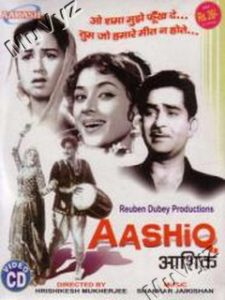
The song O shama mukhe phoonk de is from the 1962 Hrishikesh Mukherjee movie Aashiq starring Raj Kapoor, Nanda and Padmini. The team of Hasrat Jaipuri, Shailendra and Shankar Jaikishan created the following beautiful songs; this was of course, penned by Shailendra and has been a personal favourite since my college days. I have been fond of good Urdu poetry and Shailendra has used the metaphor of Shama and Parwana to bring out the contradiction in the situations of the lead actors in the dance.
| 1 | “Yeh To Kaho Kaun Ho Tum” | Mukesh |
| 2 | “Tum Jo Hamare Meet Na Hote” | Mukesh |
| 3 | “Mehtab Tera Chehra” | Mukesh, Lata Mangeshkar |
| 4 | “Main Aashiq Hoon Baharon Ka” | Mukesh |
| 5 | “Jhanan Jhan Jhanke Apni Payal” | Lata Mangeshkar |
| 6 | “Lo Aai Milan Ki Raat” | Lata Mangeshkar |
| 7 | “O Shama Mujhe Phoonk De” | Mukesh, Lata Mangeshkar |
| 8 | “Tum Aaj Mere Sang Hans Lo” | Mukesh |
When you listen to and watch the song, you are instantly taken in by the treatment that Shankar Jaikishan have given the song. It starts with a slow tempo and then it picks up and changes almost into a frenzy. Meanwhile the female dancers are swaying like flames of candles (Shama) trying to entrap the Parwana (in this case Raj Kapoor) who, like the proverbial Parwana, is only too eager to sacrifice himself in love. One of the reasons that I love the music duo of S-J is that they cause unmatcheable harmony between lyrics and notes and if then we have a director of the eminence of Hrishikesh Mukherjee, the entire sequence leaves you breathless. Finally, I have this to say about S-J’s music: in case of other composers, they merely compose, S-J take you along on a musical journey and when you arrive at the destination, in this case at minute 6:46, you feel close to having been on a roller coaster ride.
Please enjoy in Raag Bhairavi, Tal Kaherava: O shama mukhe phoon de ….
Mu : O shamaa mujhe phuu.nk de
Mai.n na mai.n rahuu.N tuu na tuu rahe
Yahii ishq kaa hai dastuur -2
La : Paravaane jaa hai ajab chalan
Yahaa.N jiite jii apanaa milan
Qismat ko nahii.n ma.njuur -2
Shaam se lekar roz sahar tak tere li_e mai.n saarii raat jalii
Maine to haay ye bhii na jaanaa kab din Duubaa kab raat Dhalii
Phir bhii hai.n milane se majabuur -2
Mu : O shamaa mujhe …
Patthar dil hai.n ye jagavaale jaane na ko_ii mere dil kii jalan -2
Jab se hai janamii pyaar kii duniyaa tujhako hai merii mujhe terii lagan
Tum bin ye duniyaa hai benuur -2
La : Paravaane jaa hai …
Mu : Haay rii qismat a.ndhii qismat dekh sakii naa terii-merii Kushii
La : Haay rii ulfat bebas ulfat ro ke thakii jal-jal ke marii
Do : Dil jo mile kisakaa thaa qasuur -2
Mu : O shamaa mujhe …
La : Paravaane jaa hai …
We have intended to learn about Raaga based music whilst we entertain ourselves with Raaga based songs. So, lets, once again, take stock of our collective learning so far:
- On the first day we learnt about the Raaga system devised by Pandit Vishnu Narayan Bhatkhande, which is the prevalent system in Hindustani Classical Music and based on ten Thaats.
- On the second day we learnt about Tal or Taal.
- On the third day we learnt about characteristics of Raagas that included Swar, Jati, Thaat, Arohana and Avarohana, Vadi, Samvadi and Pakad.
- On the fourth day, we learnt about Sargam.
- On the fifth day, we learnt about notations used in Indian classical music or simply Swar Lipi.
- On the sixth day, we learnt about the Ras (sentiments) that Raagas evoke.
- On the seventh day, we learnt about various types of Swar: Shuddha, Achal, Vikrut, Komal and Teevra.
- On the eighth day, we learnt the parts of a composition in Indian Classical Music.
- On the ninth day, we learnt the names of some of the popular instruments used in Indian Classical Music.
- On the tenth day, we learnt about the sources of names of Raagas.
- On the eleventh day, we learnt about why Bhairavi is the first raag to be taught to beginners and also why it is the last in a performance.
- On the twelfth day, we learnt about Khammaj Thaat.
- On the thirteenth day, we learnt about Tal Punjabi Theka or Sitarkhani.
- On the fourteenth day, we learnt about Alap.
- On the fifteenth day, we learnt about List of Raagas (Raagmala) in my favourite book: Sri Guru Granth Sahib.
- On the sixteenth day, we learnt about tips for raaga identification.
- On the seventeenth day, we learnt the basics of Gharana system.
- On the eighteenth day, we learnt about Filmi Sangeet.
- On the nineteenth day, we learnt about the commonest Tal in Raagas: Tintal.
- On the twentieth day, we learnt about the Kafi Thaat.
- On the twenty-first day, we learnt a little more in detail about the classification of Raagas.
- On the twenty-second day, we learnt the essential differences between Bhairavi and Bhairav.
- On the twenty-third day, we learnt a little more in detail about the Jati or Jaati of a raaga.
- On the twenty-fourth day, we learnt details of Thaat Bilawal, the most basic thaat in the Bhatkhande’s system of raagas.
- On the twenty-fifth day, we learnt about Tintal.
- On the twenty-sixth day, we learnt in detail about the Raaga – Samay linkage.
- On the twenty-seventh day, we learnt about Lehar.
- On the twenty-eighth day, we learnt about the history of the Hindustani Music.
- On the twenty-ninth day, we learnt about Dhrupad.
- On the thirtieth day, we learnt about Rupaktal that I was introduced to, a few months back, by my friend Anand Desai.
- On the thirty-first day, we learnt about Khayal.
- On the thirty-second day, we learnt about Thumri.
- On the thirty-third day, we learnt about Tappa.
- On the thirty-fourth day, we learnt about Tarana.
- On the thirty-fifth day, we learnt about Tal Dipchandi (Moghali).
- On the thirty-sixth day, we learnt about Tabla.
- On the thirty-seventh day, we learnt about Kirtan.
- On the thirty-eighth day, we learnt about Pakhawaj.
- On the thirty-ninth day, we learnt about Hori.
- On the fortieth day, we learnt about Dadra.
- On the forty-first day, we learnt about Kajri.
- On the forty-second day, we learnt about Chaiti.
- On the forty-third day, we learnt about Sarangi.
- On the forty-fourth day, we learnt about Shehnai.
- On the forty-fifth day, we learnt about Sarod.
- On the forty-sixth day, we learnt about Bansuri.
- On the forty-seventh day, we learnt about Ektal and Tanpura.
- On the forty-eighth day, we learnt about Veena.
- On the forty-ninth day, we repeated our learning of Veena with a small excitement added.
- On the fiftieth day, we learnt about Dilruba/Esraj.
- On the fifty-first day, we learnt about Jaltarang.
- On the fifty-second day we learnt about Qawwali.
- On the fifty-third day, we learnt about Sitar.
- On the fifty-fourth day, we learnt about Surbahar.
- On the fifty-fifth day, we learnt about Harmonium.
- On the fifty-sixth day, we learnt about Santoor.
- On the fifty-seventh day, we learnt about Swarmandal.
- On the fifty-eighth day, we learnt about the Shruti Box.
- On the fifty-ninth day, we learnt about Alankar.
- On the sixtieth day, we learnt about singing in Aakaar.
- On the sixty-first day, we learnt about the Classification of Indian Musical Instruments.
- On the sixty-second day, we learnt a little about Carnatic Music.
- On the sixty-third day, we learnt about Natya Shastra.
- On the sixty-fourth day, we learnt about evolution of musical instruments in India down the ages.
- On the sixty-fifth day, we learnt about Riyaaz.
- On the sixty-sixth day, we looked at a list of Raagas in Hindustani Classical Music.
- On the sixty-seventh day, we learnt about the health benefits of raagas.
- On the sixty-eighth day, we learnt a little more comprehensively about the moods and emotions that raagas evoke.
- On the sixty-ninth day, we learnt about a mobile application to help identify raagas.
- On the seventieth day, we learnt about Melakarta Raagas.
- On the seventy-first day, we learnt about Sangita Makarand.
- On the seventy-second day, we learnt about TaalMala an Android application for personalized accompaniment of musical instruments during Riyaaz or even during Concert.
- On the seventy-third day, we learnt about Indian Classical Ragas, an Android application for mobile phones.
- On the seventy-fourth day, we learnt about Saregama Classical, another application for Classical Raagas.
- On the seventy-fifth day, we learnt about a free online service available to learn Indian Classical Music.
- On the seventy-sixth day, we learnt about List of Hindustani Classical Musical Festivals in India and Abroad.
- On the seventy-seventh day, we learnt about List of Carnatic Musical Festivals in India and Abroad.
- On the seventy-eighth day, we learnt about Jhaptal.
- On the seventy-ninth day, we learnt about Ektal.
- On the eightieth day, we learnt about Tivra Tal.
- And today, on the eighty-first day, we learnt about the greatest Rudra Veena player ever: Ustaad Asad Ali Khan.
There is much more still to be learnt and enjoyed.
Please stay tuned!
